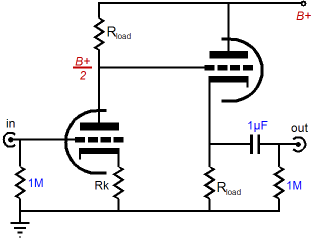Anyway, long story short, I rerouted the grounds and the hum is much less, but not gone. One thing I am positive of, is that I should get new tubes. Not that my 6N1Ps are junk, but I think they can be subbed in for 6922s and 6DJ8s under higher voltages, but at 180v B+, I do not think they are as readily rollable. Just my theory, and maybe way off.
I, as stated before, am working with a fairly low B+ 175-180v. I found this schematic, and thought this would be a good starting point for a rebuild. It looks very attractive due to the low output impedance for both SS and tube amps.

1) I built a regulated 6v DC filament board last night with 2,000uf filtering on it even though I'm positive there is no filament hum in the amp (I can cut the filament winding while the preamp is playing and get no change in sound).
2) I'm going to rework the PS board with a better star point system by cutting away the first filter cap after the rectifier from the rest of the ground bus and will run its own wire to the star point.
3) I added that pot on the input. Does that 1M resistor circled need to be there?
4) When you build a line stage, how do you ground your inputs/outputs? Do you ground each end of the shielded wires at all points?
5) Do you tie your cathodes together and run them as a separate return wire to the star point?
I ordered some 6DJ8 tubes yesterday, so they should be in by Friday or so. I am just not giving up on this freaking project! I believe you can make a quiet tube preamp, but I have yet to do so.
Thanks for any help!
Blair


 of a time taming it down. The oscillation showed up as excessive "hiss" noise and the tubes were extremely microphonic.
of a time taming it down. The oscillation showed up as excessive "hiss" noise and the tubes were extremely microphonic.






